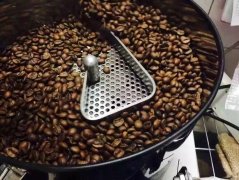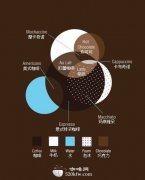The growth cycle of coffee and picking coffee beans are the seeds of coffee trees.

Coffee beans are the seeds of coffee trees. After three or four years of growth, the coffee tree matures and begins to bear fruit, with one fruit arranged in clusters or clusters along the branches. The outside of the seed is a layer of peel, which can be picked as soon as it turns red. Under the red skin (exocarp) there is a layer of pulp (mesocarp), which is a small thin layer, and then a layer of parchment-like substance-endocarp. In all of these peels, there are usually two beans with opposite planes, and the beans have a thin film or skin on the outside. Most Arabica coffee beans mature from June to August and Robart coffee beans from September to October. Therefore, although in some countries where the dry and wet seasons are not obvious, such as Colombia and Kenya, there are two flowering periods a year, that is, two harvests, strictly speaking, only once a year. Due to different regions, the harvest time is also different.
Regions north of the equator (such as Ethiopia and Central America) are generally harvested in September-November. South of the equator, such as Brazil and Zimbabwe (Zimbabwe), although the harvest can last until August, the main one is in April or May. Countries in the equatorial region, such as Uganda (Uganda) and Colombia, can harvest all year round, especially those plantations that make good use of different elevations. As a result, there may be new coffee beans for most of the year.
As far as picking itself is concerned, there are two ways: one is picking in pieces, that is, picking all the beans after a walk in the garden, and the other is selective picking, that is, at intervals of 8-10 days. walk between the trees a few times and pick only the ripe red berries. Selective picking is more expensive and labor-intensive than picking in pieces, and it is generally only used for Arabica coffee beans, especially those that need to be washed. The number of coffee beans picked depends on a variety of factors, the most obvious being the height of the trees and the layout of the farm or plantation. On average, the average farm picker can pick 50-100 kilograms a day. But only 20% of these weights are real coffee beans, so the average picker can only pick 10-20 kilograms of coffee beans. The coffee beans are packed in bags with a standard weight of 45-60 kilograms. As a result, it takes 3-6 days for a worker to fill a bag. It has been calculated that the cost of harvesting a plantation or farm is half of the total cost of the year.
In Brazil, people have tried many times to reduce these costs by mechanical picking. The machine can shake branches across the coffee tree so that the berries that become loose because they are ripe will fall into the funnel. Mechanical pickers only work in areas with better natural conditions, and they need to be adjusted in advance, because they can only be used where the trees can be planted in rows straight, and afterwards need to check the coffee beans picked by the machine. pick out the leaves and branches that have fallen in the funnel. Therefore, a large part of the coffee is picked by hand, which requires a lot of seasonal work, and pickers should be careful not to pick coffee beans that are not ripe, bad or too ripe, as they will affect the overall quality of the coffee harvested. Coffee beans that are not so good are classified as "ordinary", "sour" or "fermented", and the last one is very bad.
Excerpt from the barista tutorial
Important Notice :
前街咖啡 FrontStreet Coffee has moved to new addredd:
FrontStreet Coffee Address: 315,Donghua East Road,GuangZhou
Tel:020 38364473
- Prev

Species of coffee trees in Arabica, Robusta and Liberia
Types of coffee trees at present, the best quality coffee beans in the world mainly come from Arabica, Robusta and Liberia, which are mainly proud of coffee trees in the three places. 1. The origin of Arabica coffee tree is Ethiopia, and its coffee bean production accounts for 70% of the world's output. The world-famous Blue Mountain Garffin, Mocha Coffee and so on are almost all Arabica species. Arabica coffee
- Next

Maggie represents a kind of beauty and simplicity.
Maggiadot represents a kind of beauty and simplicity. It is easy to make macchiato coffee. Add two tablespoons of soft milk foam to the Espresso to make a cup of macchiato. Marchiato tastes heavier than cappuccino because she only adds foam instead of heating milk. Since the density of milk foam will be affected when it comes into contact with air, Maggialdo should do its best after it is done.
Related
- Beginners will see the "Coffee pull flower" guide!
- What is the difference between ice blog purified milk and ordinary milk coffee?
- Why is the Philippines the largest producer of crops in Liberia?
- For coffee extraction, should the fine powder be retained?
- How does extracted espresso fill pressed powder? How much strength does it take to press the powder?
- How to make jasmine cold extract coffee? Is the jasmine + latte good?
- Will this little toy really make the coffee taste better? How does Lily Drip affect coffee extraction?
- Will the action of slapping the filter cup also affect coffee extraction?
- What's the difference between powder-to-water ratio and powder-to-liquid ratio?
- What is the Ethiopian local species? What does it have to do with Heirloom native species?

